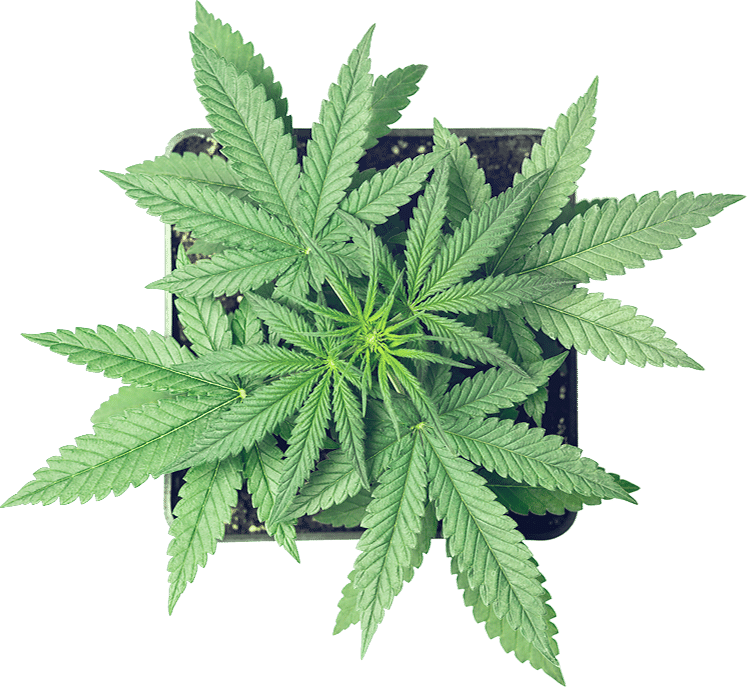High CBD
High-CBD strains tend to deliver very clear-headed, functional effects without the euphoric high associated with high-THC strains. These strains are ideal for patients who are extremely sensitive to the side effects of THD, which can include anxiety, paranoia, and dizziness. This is most commonly used for patients to medicate throughout the day to control pain, inflammation, anxiety, or other chronic conditions.
Sativa
Sativa is a primary marijuana strain that binds to CB1 and CB2 receptors and is known to be energizing and cerebral. Sativa strains are ideal for activities during the daytime that require physical activity or a high level of social interaction. In terms of effects, sativa strains provide a high for your mind, jumpstarting creativity, focus and mental energy. Sativa is commonly used for depression, pain relief, and muscle relaxation.
Hybrid
Hybrids are a primary marijuana strain type that live between indicas and sativas. Hybrid strains are classified by their ability to produce a unique balance of indica and sativa effects. Hybrids can be both energizing and relaxing, depending on their specific strain lineage.
Indica
Indica is a primary marijuana strain type known to be calming and relaxing. They have a higher affinity to CB2 receptors and are ideal for activities during the evening that require little to no physical activity or social interaction. In terms of effects, indica strains provide a high for your mind and body, creating a sedated and sleepy state of mind. Indica is commonly used for sleeping disorders, anxiety, pain, and muscle relaxation.
The medical use of cannabis has been around for thousands of years. There are certain chemicals in cannabis, primarily Delta-9-tetrahydrocannabinol (THC) and cannabidiol (CBD), that help treat certain diseases or conditions. Below are just a few health benefits of cannabis. Talk with your doctor or our staff to find the most appropriate strain and type of cannabis for your condition.
Promotes relaxation
Certain strains of cannabis can help patients with anxiety feel more relaxed, especially those with specific health conditions.
Fights insomnia
A restful sleep is essential for many patients with a variety of conditions. Cannabis can be used as an effective sleep aid.
Removes headache
Cannabis is an effective treatment for patients suffering from acute and often debilitating migraine headaches.
Increases appetite
Cannabis is often helpful to cancer patients who have lost their appetite due to their treatments.
Relieves pain
Cannabis has long been used as a powerful medicine to counteract pain and is an effective alternative to certain opioids.
Improves mood
Cannabis is used to improve the mood and mental health of patients with chronic ailments or certain psychiatric conditions.

adverse effects
General side effects of cannabis: Somnolence, headaches, dry mouth, hypotension, tachycardia/bradycardia, palpitations, sedation, difficulty concentrating, dizziness, changes in mood, altered senses
- Smoking/Vaporizing cannabis: coughing, increased risk of lung/respiratory infections or diseases, increased sputum production or purulence, conjunctival irritation. Topical or oral administration may be preferred to reduce of these side effects.
- Oral administration: Cannabis users may be unaware of the amount of cannabis they may have ingested using edible formulations. The most common adverse effect/downside to oral administration is the higher risk for overdose due to delayed onset, ease of use/administration, and variability in potency between products. This can be avoided with careful selection of products and proper patient counseling.
- Short-term use: Impaired short-term memory, impaired motor coordination, altered judgement, paranoia, changing is mood
- Long-term use: Addiction (9%), cognitive impairment, brain development (mostly observed in adolescents)
- Adverse effects at high doses: agitation, confusion, sedation, psychosis, hallucinations
Drug-interactions (not all-inclusive):
- May decrease the the pharmacological effect of: theophylline, clozapine, chlorpromazine
- May increase the pharmacological effect of: macolides, calcium channel blockers, antihistamines, haloperidol, sildenafil, SSRIs, TCAs, tacrolimus
- May have an additive effect when administered with cannabis: opioids, anxiolytics
Missouri Poison Control: (800) 222-1222
Resources:
- Barrus DG, Capogrossi KL, Cates SC, et al. Tasty THC: Promises and Challenges of Cannabis Edibles. Methods Rep RTI Press. 2016;2016:10.3768/rtipress.2016.op.0035.1611. doi:10.3768/rtipress.2016.op.0035.161
- Borgelt LM, Franson KL, Nussbaum AM, Wang GS. The Pharmacological and Clinical Effects of Medical Cannabis. Pharmacotherapy 2013;33(2):195-209.
- Bridgeman MB, Abazia DT. Medicinal Cannabis: History, Pharmacology, And Implications for the Acute Care Setting. P T. 2017;42(3):180–188.
- Franson KL. Medical Cannabis. Skaggs School of Pharmacy and Pharmaceutical Sciences.
- Pertwee RG. The diverse CB1 and CB2 receptor pharmacology of three plant cannabinoids: delta9-tetrahydrocannabinol, cannabidiol and delta9-tetrahydrocannabivarin. Br J Pharmacol. 2008;153(2):199–215. doi:10.1038/sj.bjp.0707442



